service schedule VOLKSWAGEN UP! 2021 Owner´s Manual
[x] Cancel search | Manufacturer: VOLKSWAGEN, Model Year: 2021, Model line: UP!, Model: VOLKSWAGEN UP! 2021Pages: 211, PDF Size: 5.98 MB
Page 1 of 211
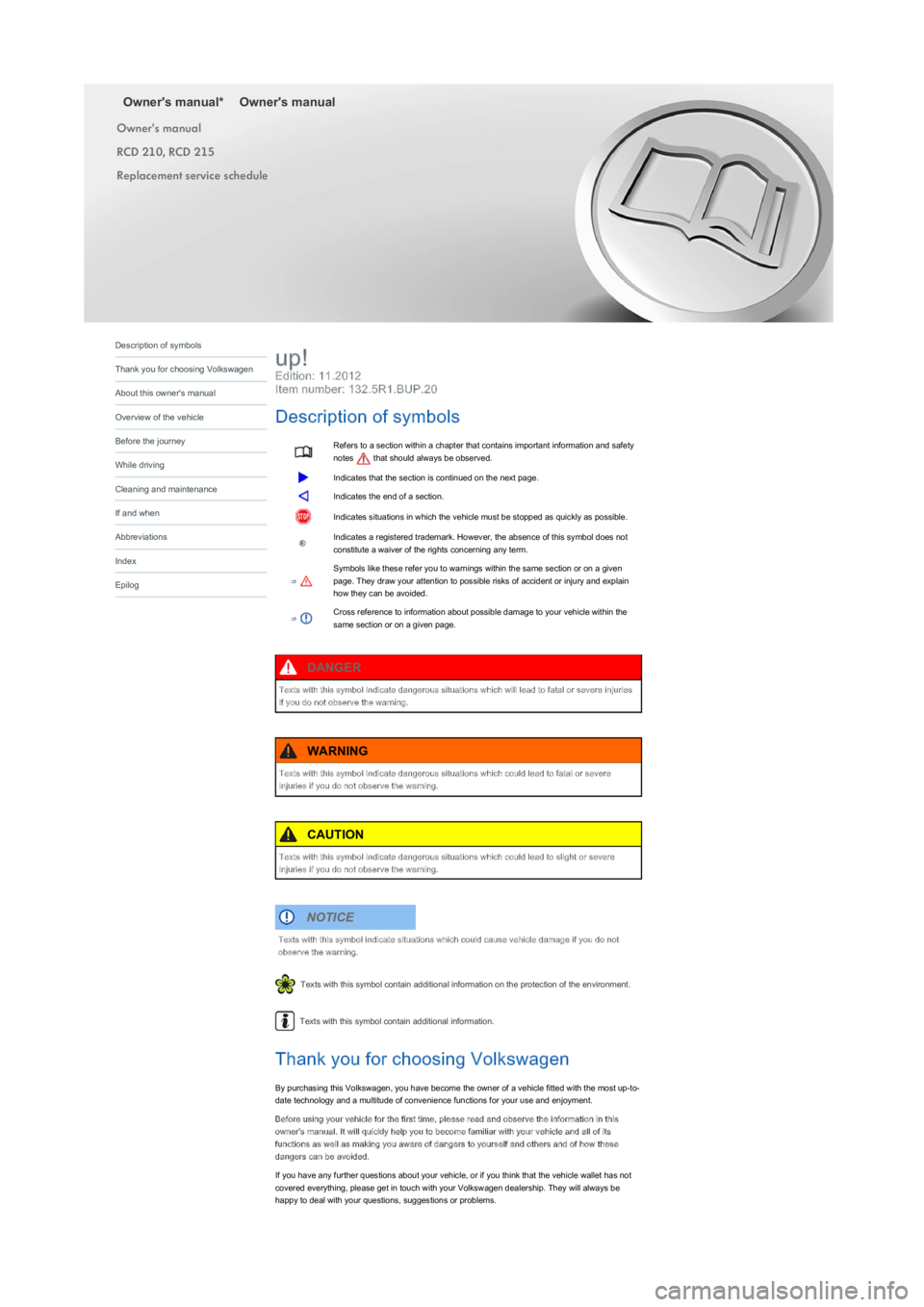
Owner's manual*Owner's manual
Owner's manual
RCD 210, RCD 215
Replacement service schedule
Edition: 11.2012
Item number: 132.5R1.BUP.20
Refers to a section within a chapter that contains important information and safety
notes that should always be observed.
Indicates that the section is continued on the next page.
Indicates the end of a section.
Indicates situations in which the vehicle must be stopped as quickly as possible.
®Indicates a registered trademark. However, the absence of this symbol does not
constitute a waiver of the rights concerning any term.
⇒
Symbols like these refer you to warnings within the same section or on a given
page. They draw your attention to possible risks of accident or injury and explain
how they can be avoided.
⇒Cross reference to information about possible damage to your vehicle within the
same section or on a given page.
Texts with this symbol contain additional information on the protection of the environment.
Texts with this symbol contain additional information.
Thank you for choosing Volkswagen
By purchasing this Volkswagen, you have become the owner of a vehicle fitted with the most up-to-
date technology and a multitude of convenience functions for your use and enjoyment.
Before using your vehicle for the first time, please read and observe the information in this
owner's manual. It will quickly help you to become familiar with your vehicle and all of its
functions as well as making you aware of dangers to yourself and others and of how these
dangers can be avoided.
If you have any further questions about your vehicle, or if you think that the vehicle wallet has not
covered everything, please get in touch with your Volkswagen dealership. They will always be
happy to deal with your questions, suggestions or problems.
up!
Description of symbols
Texts with this symbol indicate dangerous situations which will lead to fatal or severe injuries
if you do not observe the warning.
DANGER
Texts with this symbol indicate dangerous situations which could lead to fatal or severe
injuries if you do not observe the warning.
WARNING
Texts with this symbol indicate dangerous situations which could lead to slight or severe
injuries if you do not observe the warning.
CAUTION
Texts with this symbol indicate situations which could cause vehicle damage if you do not
observe the warning.
NOTICE
Description of symbols
Thank you for choosing Volkswagen
About this owner's manual
Overview of the vehicle
Before the journey
While driving
Cleaning and maintenance
If and when
Abbreviations
Index
Epilog
Page 2 of 211
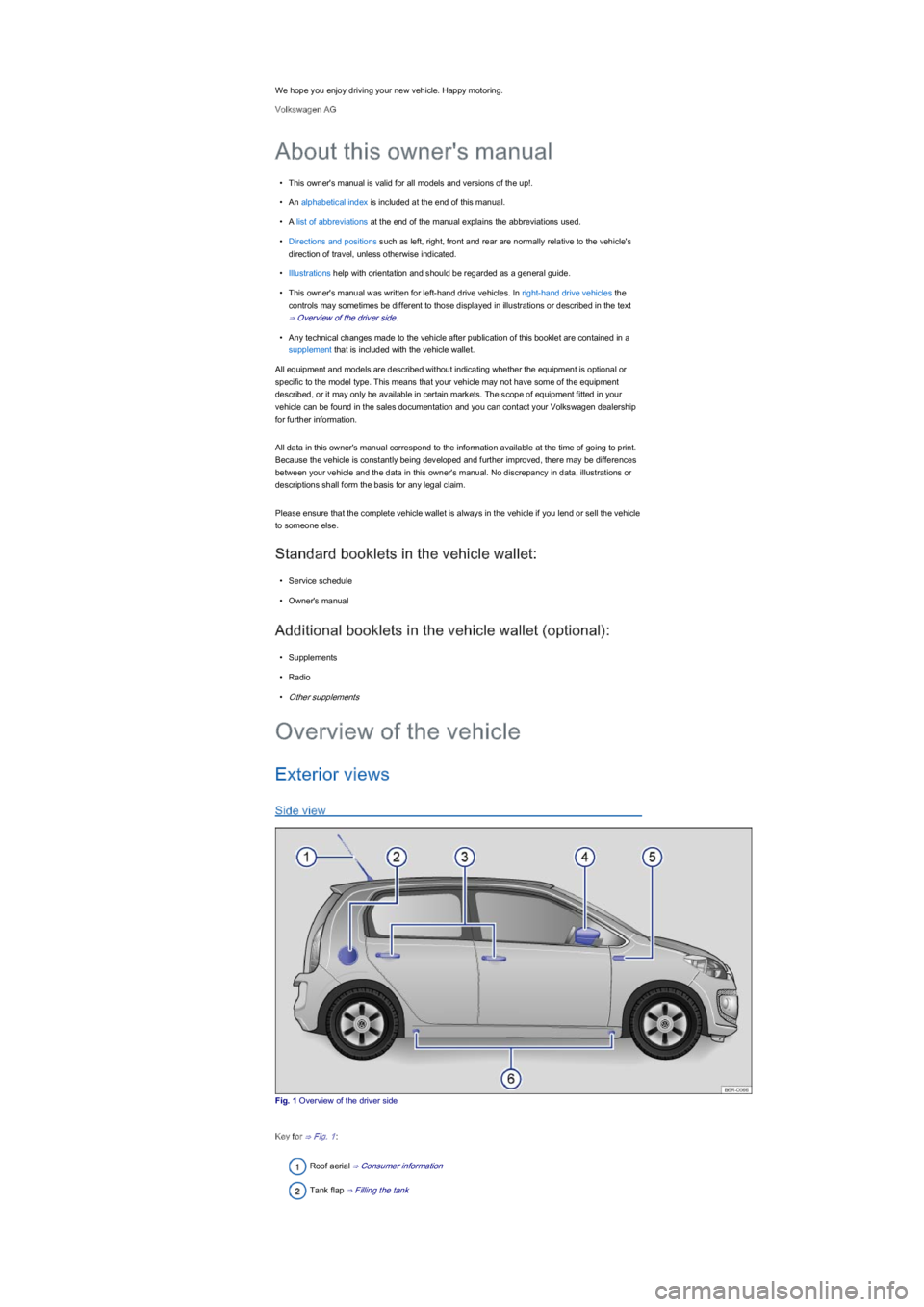
We hope you enjoy driving your new vehicle. Happy motoring.
Volkswagen AG
•This owner's manual is valid for all models and versions of the up!.
•An alphabetical index is included at the end of this manual.
•A list of abbreviations at the end of the manual explains the abbreviations used.
•Directions and positions such as left, right, front and rear are normally relative to the vehicle's
direction of travel, unless otherwise indicated.
•Illustrations help with orientation and should be regarded as a general guide.
•This owner's manual was written for left-hand drive vehicles. In right-hand drive vehicles the
controls may sometimes be different to those displayed in illustrations or described in the text
⇒ Overview of the driver side.
•Any technical changes made to the vehicle after publication of this booklet are contained in a
supplement that is included with the vehicle wallet.
All equipment and models are described without indicating whether the equipment is optional or
specific to the model type. This means that your vehicle may not have some of the equipment
described, or it may only be available in certain markets. The scope of equipment fitted in your
vehicle can be found in the sales documentation and you can contact your Volkswagen dealership
for further information.
All data in this owner's manual correspond to the information available at the time of going to print.
Because the vehicle is constantly being developed and further improved, there may be differences
between your vehicle and the data in this owner's manual. No discrepancy in data, illustrations or
descriptions shall form the basis for any legal claim.
Please ensure that the complete vehicle wallet is always in the vehicle if you lend or sell the vehicle
to someone else.
Standard booklets in the vehicle wallet:
•Service schedule
•Owner's manual
Additional booklets in the vehicle wallet (optional):
•Supplements
•Radio
•Other supplements
Exterior views
Side view
Fig. 1 Overview of the driver side
Key for ⇒ Fig. 1:
Roof aerial ⇒ Consumer information
Tank flap ⇒ Filling the tank
About this owner's manual
Overview of the vehicle
Page 9 of 211
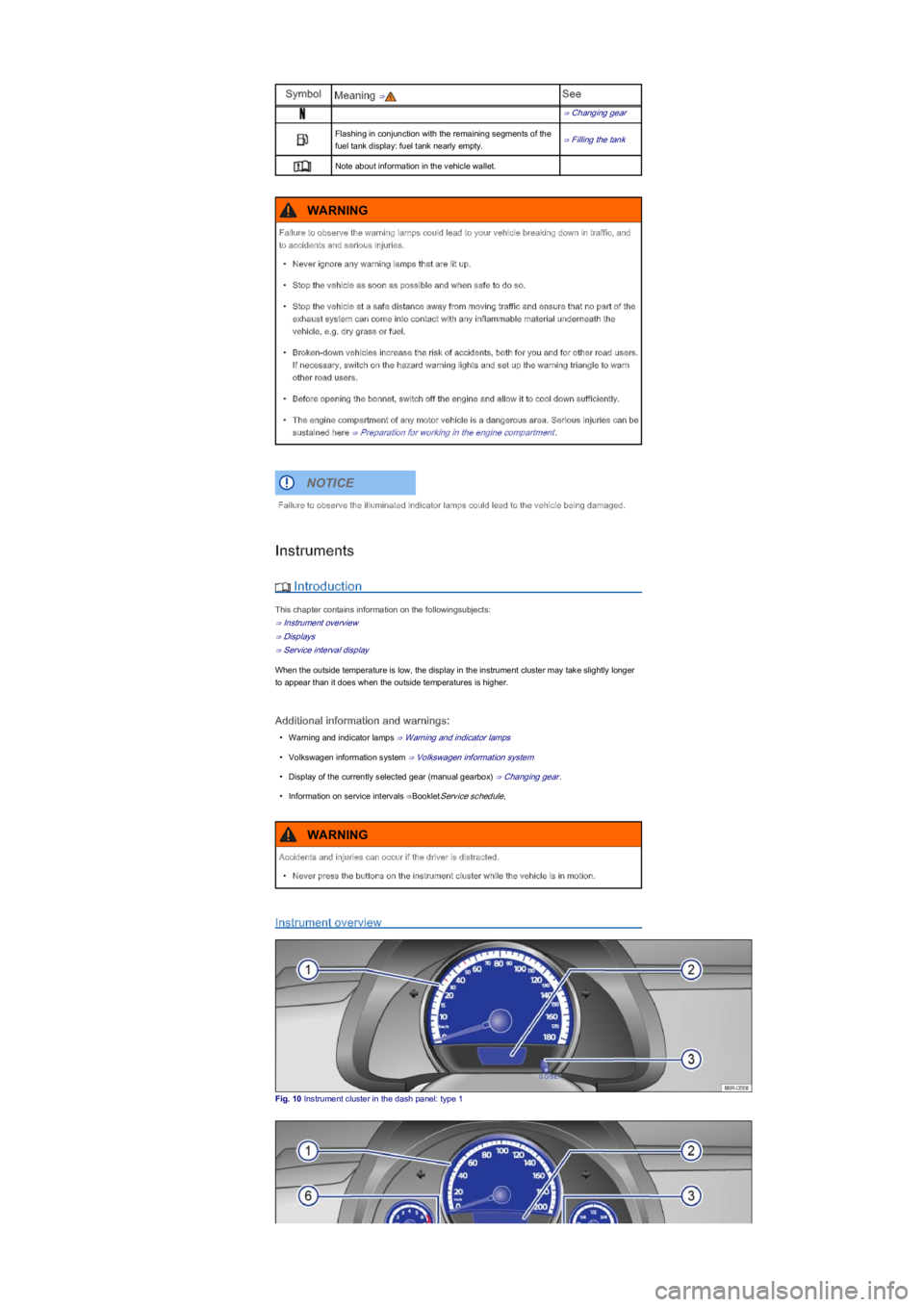
SymbolMeaning ⇒See
⇒ Changing gear
Flashing in conjunction with the remaining segments of the
fuel tank display: fuel tank nearly empty.⇒ Filling the tank
Note about information in the vehicle wallet.
Instruments
Introduction
This chapter contains information on the followingsubjects:
⇒ Instrument overview
⇒ Displays
⇒ Service interval display
When the outside temperature is low, the display in the instrument cluster may take slightly longer
to appear than it does when the outside temperatures is higher.
Additional information and warnings:
•Warning and indicator lamps ⇒ Warning and indicator lamps
•Volkswagen information system ⇒ Volkswagen information system
•Display of the currently selected gear (manual gearbox) ⇒ Changing gear.
•Information on service intervals ⇒BookletService schedule,
Instrument overview
Fig. 10 Instrument cluster in the dash panel: type 1
Failure to observe the warning lamps could lead to your vehicle breaking down in traffic, and
to accidents and serious injuries.
•Never ignore any warning lamps that are lit up.
•Stop the vehicle as soon as possible and when safe to do so.
•Stop the vehicle at a safe distance away from moving traffic and ensure that no part of the
exhaust system can come into contact with any inflammable material underneath the
vehicle, e.g. dry grass or fuel.
•Broken-down vehicles increase the risk of accidents, both for you and for other road users.
If necessary, switch on the hazard warning lights and set up the warning triangle to warn
other road users.
•Before opening the bonnet, switch off the engine and allow it to cool down sufficiently.
•The engine compartment of any motor vehicle is a dangerous area. Serious injuries can be
sustained here ⇒ Preparation for working in the engine compartment.
WARNING
Failure to observe the illuminated indicator lamps could lead to the vehicle being damaged.
NOTICE
Accidents and injuries can occur if the driver is distracted.
•Never press the buttons on the instrument cluster while the vehicle is in motion.
WARNING
Page 12 of 211
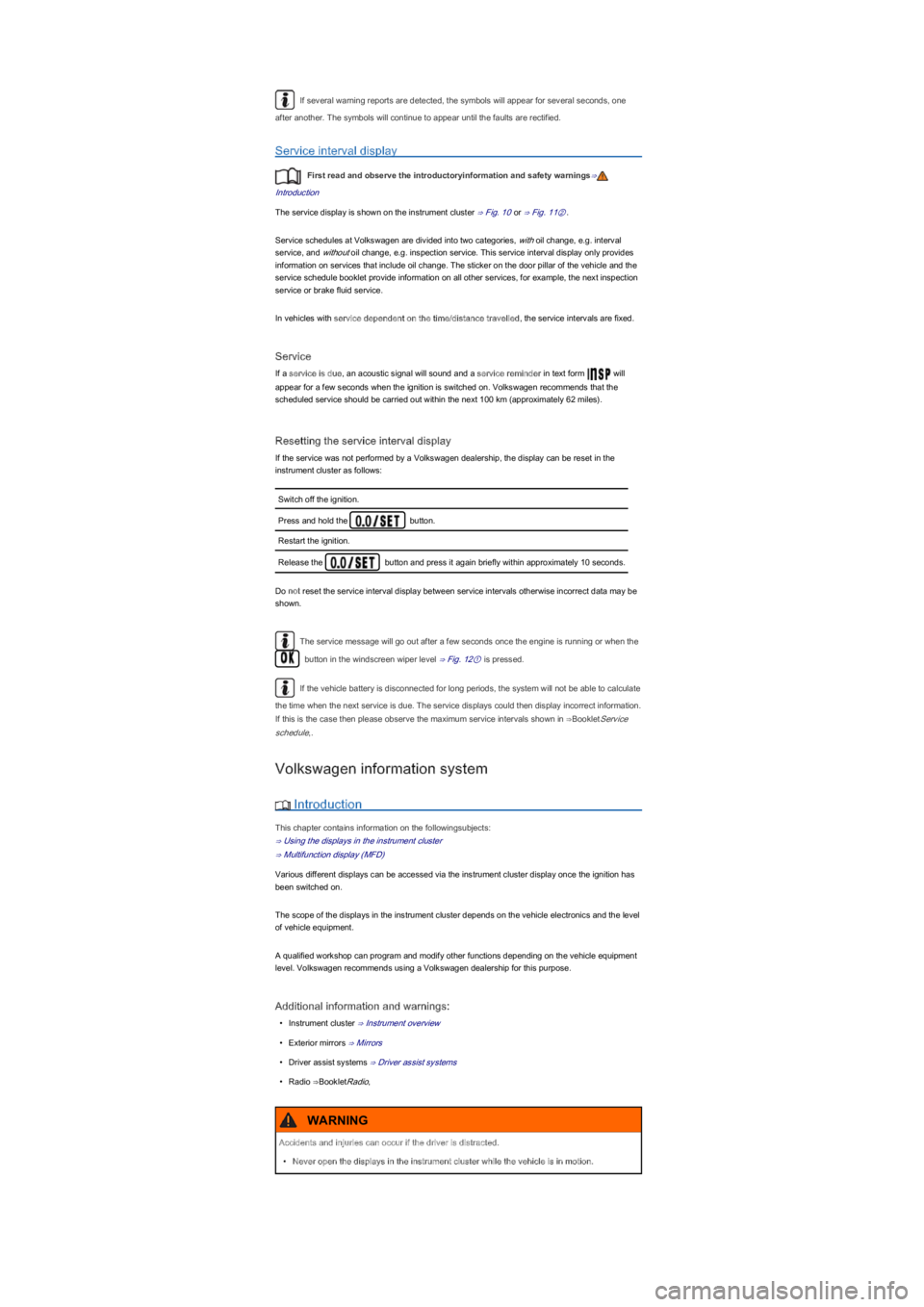
If several warning reports are detected, the symbols will appear for several seconds, one
after another. The symbols will continue to appear until the faults are rectified.
Service interval display
First read and observe the introductoryinformation and safety warnings⇒
Introduction
The service display is shown on the instrument cluster ⇒ Fig. 10 or ⇒ Fig. 11②.
Service schedules at Volkswagen are divided into two categories, with oil change, e.g. interval
service, and without oil change, e.g. inspection service. This service interval display only provides
information on services that include oil change. The sticker on the door pillar of the vehicle and the
service schedule booklet provide information on all other services, for example, the next inspection
service or brake fluid service.
In vehicles with service dependent on the time/distance travelled, the service intervals are fixed.
Service
If a service is due, an acoustic signal will sound and a service reminder in text form will
appear for a few seconds when the ignition is switched on. Volkswagen recommends that the
scheduled service should be carried out within the next 100 km (approximately 62 miles).
Resetting the service interval display
If the service was not performed by a Volkswagen dealership, the display can be reset in the
instrument cluster as follows:
Switch off the ignition.
Press and hold the button.
Restart the ignition.
Release the button and press it again briefly within approximately 10 seconds.
Do not reset the service interval display between service intervals otherwise incorrect data may be
shown.
The service message will go out after a few seconds once the engine is running or when the
button in the windscreen wiper level ⇒ Fig. 12① is pressed.
If the vehicle battery is disconnected for long periods, the system will not be able to calculate
the time when the next service is due. The service displays could then display incorrect information.
If this is the case then please observe the maximum service intervals shown in ⇒BookletService
schedule,.
Volkswagen information system
Introduction
This chapter contains information on the followingsubjects:
⇒ Using the displays in the instrument cluster
⇒ Multifunction display (MFD)
Various different displays can be accessed via the instrument cluster display once the ignition has
been switched on.
The scope of the displays in the instrument cluster depends on the vehicle electronics and the level
of vehicle equipment.
A qualified workshop can program and modify other functions depending on the vehicle equipment
level. Volkswagen recommends using a Volkswagen dealership for this purpose.
Additional information and warnings:
•Instrument cluster ⇒ Instrument overview
•Exterior mirrors ⇒ Mirrors
•Driver assist systems ⇒ Driver assist systems
•Radio ⇒BookletRadio,
Accidents and injuries can occur if the driver is distracted.
•Never open the displays in the instrument cluster while the vehicle is in motion.
WARNING
Page 15 of 211
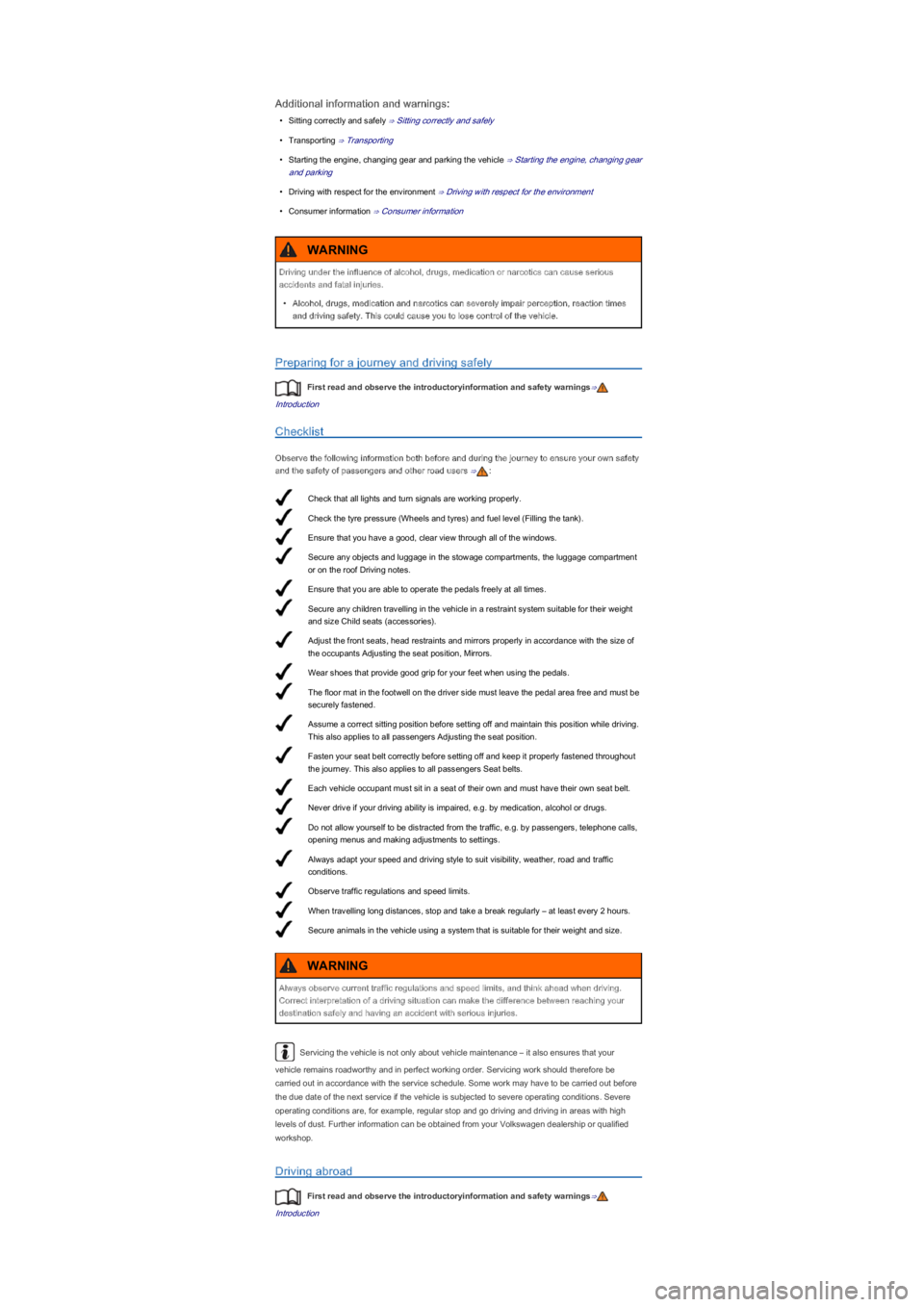
Check that all lights and turn signals are working properly.
Check the tyre pressure (Wheels and tyres) and fuel level (Filling the tank).
Ensure that you have a good, clear view through all of the windows.
Secure any objects and luggage in the stowage compartments, the luggage compartment
or on the roof Driving notes.
Ensure that you are able to operate the pedals freely at all times.
Secure any children travelling in the vehicle in a restraint system suitable for their weight
and size Child seats (accessories).
Adjust the front seats, head restraints and mirrors properly in accordance with the size of
the occupants Adjusting the seat position, Mirrors.
Wear shoes that provide good grip for your feet when using the pedals.
The floor mat in the footwell on the driver side must leave the pedal area free and must be
securely fastened.
Assume a correct sitting position before setting off and maintain this position while driving.
This also applies to all passengers Adjusting the seat position.
Fasten your seat belt correctly before setting off and keep it properly fastened throughout
the journey. This also applies to all passengers Seat belts.
Each vehicle occupant must sit in a seat of their own and must have their own seat belt.
Never drive if your driving ability is impaired, e.g. by medication, alcohol or drugs.
Do not allow yourself to be distracted from the traffic, e.g. by passengers, telephone calls,
opening menus and making adjustments to settings.
Always adapt your speed and driving style to suit visibility, weather, road and traffic
conditions.
Observe traffic regulations and speed limits.
When travelling long distances, stop and take a break regularly – at least every 2 hours.
Secure animals in the vehicle using a system that is suitable for their weight and size.
Additional information and warnings:
•Sitting correctly and safely ⇒ Sitting correctly and safely
•Transporting ⇒ Transporting
•Starting the engine, changing gear and parking the vehicle ⇒ Starting the engine, changing gear
and parking
•Driving with respect for the environment ⇒ Driving with respect for the environment
•Consumer information ⇒ Consumer information
Preparing for a journey and driving safely
First read and observe the introductoryinformation and safety warnings⇒
Introduction
Checklist
Observe the following information both before and during the journey to ensure your own safety
and the safety of passengers and other road users ⇒:
Servicing the vehicle is not only about vehicle maintenance – it also ensures that your
vehicle remains roadworthy and in perfect working order. Servicing work should therefore be
carried out in accordance with the service schedule. Some work may have to be carried out before
the due date of the next service if the vehicle is subjected to severe operating conditions. Severe
operating conditions are, for example, regular stop and go driving and driving in areas with high
levels of dust. Further information can be obtained from your Volkswagen dealership or qualified
workshop.
Driving abroad
First read and observe the introductoryinformation and safety warnings⇒
Introduction
Driving under the influence of alcohol, drugs, medication or narcotics can cause serious
accidents and fatal injuries.
•Alcohol, drugs, medication and narcotics can severely impair perception, reaction times
and driving safety. This could cause you to lose control of the vehicle.
WARNING
Always observe current traffic regulations and speed limits, and think ahead when driving.
Correct interpretation of a driving situation can make the difference between reaching your
destination safely and having an accident with serious injuries.
WARNING
Page 16 of 211
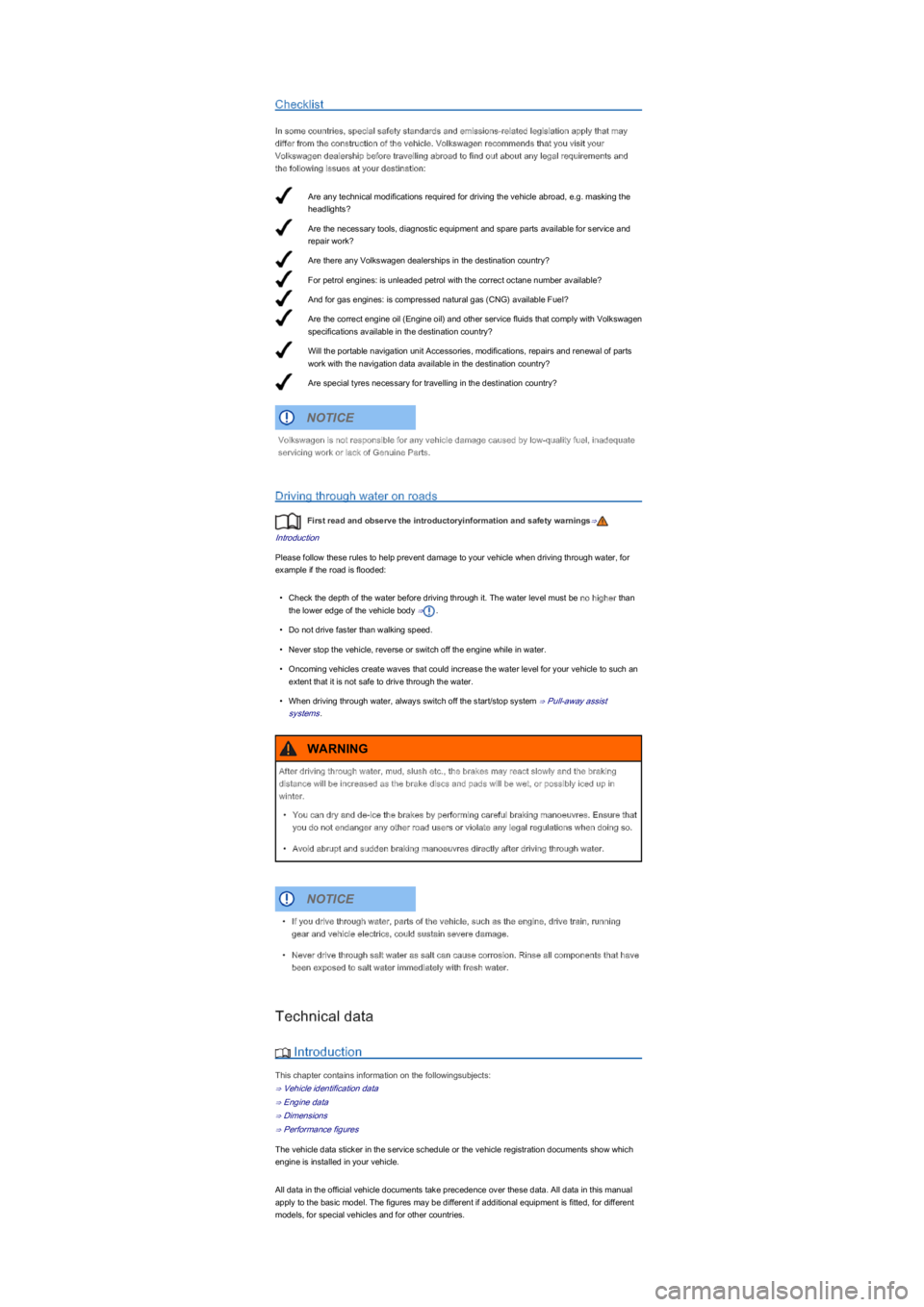
Are any technical modifications required for driving the vehicle abroad, e.g. masking the
headlights?
Are the necessary tools, diagnostic equipment and spare parts available for service and
repair work?
Are there any Volkswagen dealerships in the destination country?
For petrol engines: is unleaded petrol with the correct octane number available?
And for gas engines: is compressed natural gas (CNG) available Fuel?
Are the correct engine oil (Engine oil) and other service fluids that comply with Volkswagen
specifications available in the destination country?
Will the portable navigation unit Accessories, modifications, repairs and renewal of parts
work with the navigation data available in the destination country?
Are special tyres necessary for travelling in the destination country?
Checklist
In some countries, special safety standards and emissions-related legislation apply that may
differ from the construction of the vehicle. Volkswagen recommends that you visit your
Volkswagen dealership before travelling abroad to find out about any legal requirements and
the following issues at your destination:
Driving through water on roads
First read and observe the introductoryinformation and safety warnings⇒
Introduction
Please follow these rules to help prevent damage to your vehicle when driving through water, for
example if the road is flooded:
•Check the depth of the water before driving through it. The water level must be no higher than
the lower edge of the vehicle body ⇒.
•Do not drive faster than walking speed.
•Never stop the vehicle, reverse or switch off the engine while in water.
•Oncoming vehicles create waves that could increase the water level for your vehicle to such an
extent that it is not safe to drive through the water.
•When driving through water, always switch off the start/stop system ⇒ Pull-away assist
systems.
Technical data
Introduction
This chapter contains information on the followingsubjects:
⇒ Vehicle identification data
⇒ Engine data
⇒ Dimensions
⇒ Performance figures
The vehicle data sticker in the service schedule or the vehicle registration documents show which
engine is installed in your vehicle.
All data in the official vehicle documents take precedence over these data. All data in this manual
apply to the basic model. The figures may be different if additional equipment is fitted, for different
models, for special vehicles and for other countries.
Volkswagen is not responsible for any vehicle damage caused by low-quality fuel, inadequate
servicing work or lack of Genuine Parts.
NOTICE
After driving through water, mud, slush etc., the brakes may react slowly and the braking
distance will be increased as the brake discs and pads will be wet, or possibly iced up in
winter.
•You can dry and de-ice the brakes by performing careful braking manoeuvres. Ensure that
you do not endanger any other road users or violate any legal regulations when doing so.
•Avoid abrupt and sudden braking manoeuvres directly after driving through water.
WARNING
•If you drive through water, parts of the vehicle, such as the engine, drive train, running
gear and vehicle electrics, could sustain severe damage.
•Never drive through salt water as salt can cause corrosion. Rinse all components that have
been exposed to salt water immediately with fresh water.
NOTICE
Page 18 of 211
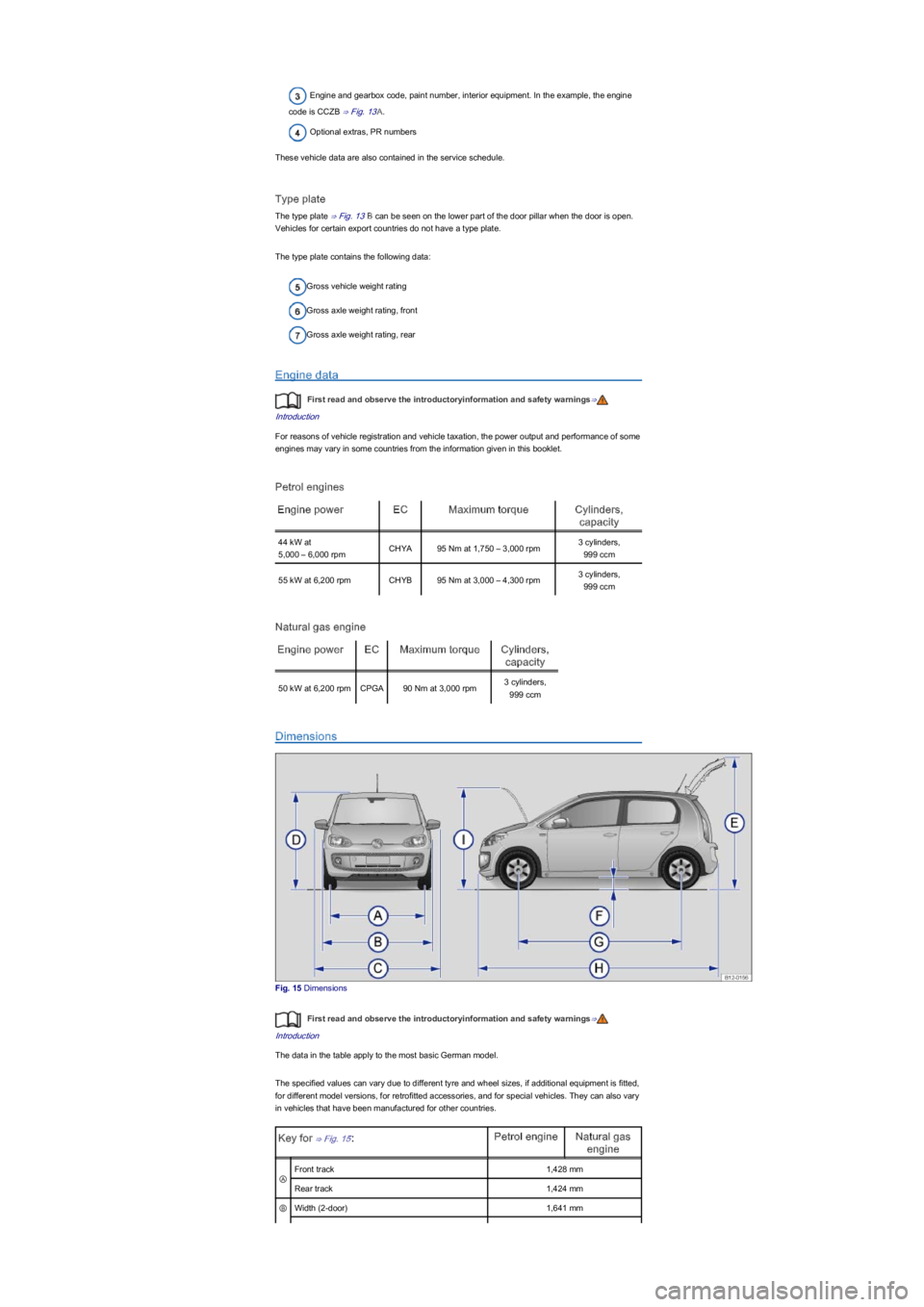
Engine and gearbox code, paint number, interior equipment. In the example, the engine
code is CCZB ⇒ Fig. 13A.
Optional extras, PR numbers
These vehicle data are also contained in the service schedule.
Type plate
The type plate ⇒ Fig. 13B can be seen on the lower part of the door pillar when the door is open.
Vehicles for certain export countries do not have a type plate.
The type plate contains the following data:
Gross vehicle weight rating
Gross axle weight rating, front
Gross axle weight rating, rear
Engine data
First read and observe the introductoryinformation and safety warnings⇒
Introduction
For reasons of vehicle registration and vehicle taxation, the power output and performance of some
engines may vary in some countries from the information given in this booklet.
Petrol engines
Engine powerECMaximum torqueCylinders,
capacity
44 kW at
5,000 – 6,000 rpmCHYA95 Nm at 1,750 – 3,000 rpm3 cylinders,
999 ccm
55 kW at 6,200 rpmCHYB95 Nm at 3,000 – 4,300 rpm3 cylinders,
999 ccm
Natural gas engine
Engine powerECMaximum torqueCylinders,
capacity
50 kW at 6,200 rpmCPGA90 Nm at 3,000 rpm3 cylinders,
999 ccm
Dimensions
Fig. 15 Dimensions
First read and observe the introductoryinformation and safety warnings⇒
Introduction
The data in the table apply to the most basic German model.
The specified values can vary due to different tyre and wheel sizes, if additional equipment is fitted,
for different model versions, for retrofitted accessories, and for special vehicles. They can also vary
in vehicles that have been manufactured for other countries.
Key for ⇒ Fig. 15:Petrol engineNatural gas
engine
Ⓐ
Front track1,428 mm
Rear track1,424 mm
ⒷWidth (2-door)1,641 mm
Page 71 of 211
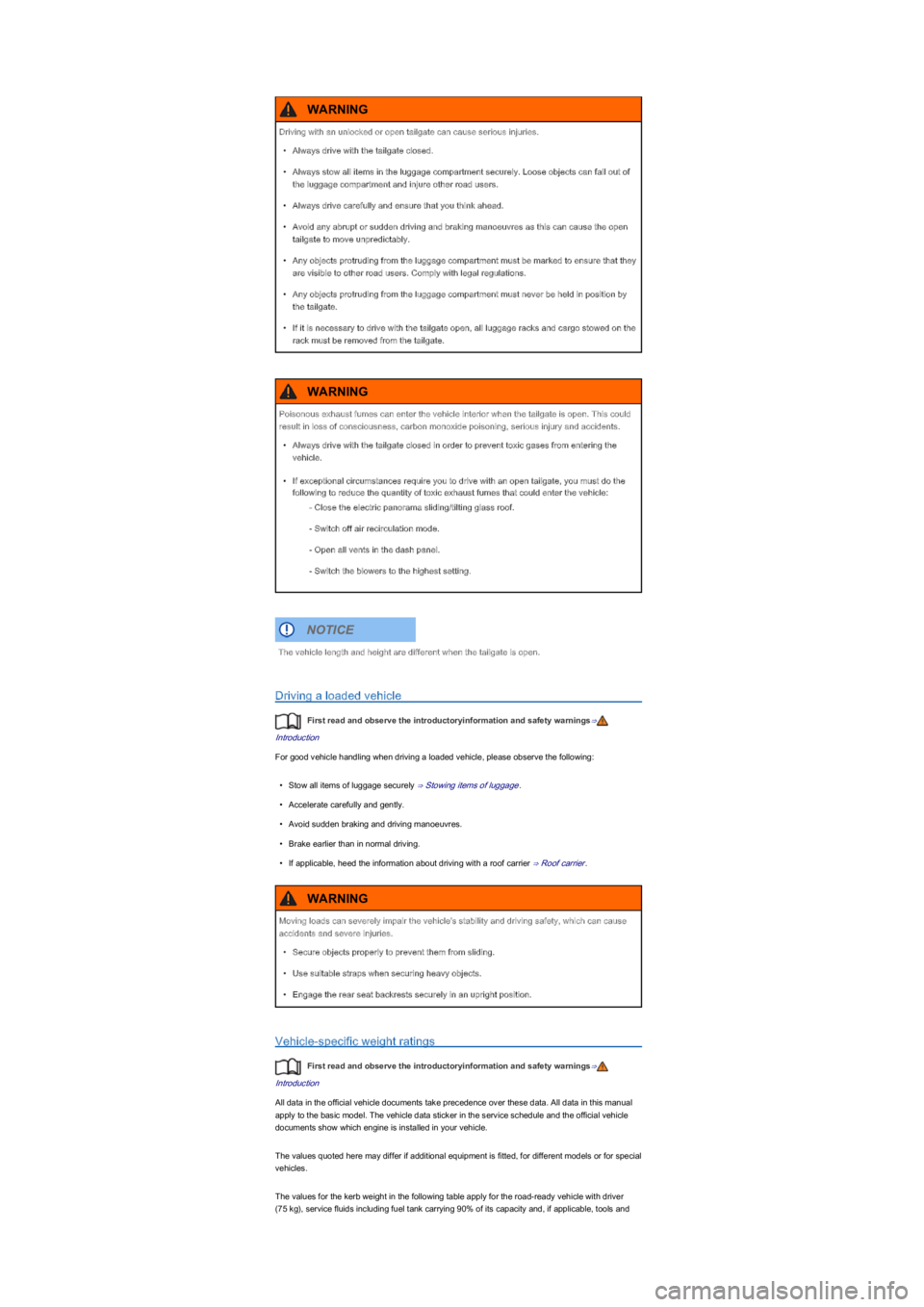
Driving a loaded vehicle
First read and observe the introductoryinformation and safety warnings⇒
Introduction
For good vehicle handling when driving a loaded vehicle, please observe the following:
•Stow all items of luggage securely ⇒ Stowing items of luggage.
•Accelerate carefully and gently.
•Avoid sudden braking and driving manoeuvres.
•Brake earlier than in normal driving.
•If applicable, heed the information about driving with a roof carrier ⇒ Roof carrier.
Vehicle-specific weight ratings
First read and observe the introductoryinformation and safety warnings⇒
Introduction
All data in the official vehicle documents take precedence over these data. All data in this manual
apply to the basic model. The vehicle data sticker in the service schedule and the official vehicle
documents show which engine is installed in your vehicle.
The values quoted here may differ if additional equipment is fitted, for different models or for special
vehicles.
The values for the kerb weight in the following table apply for the road-ready vehicle with driver
(75 kg), service fluids including fuel tank carrying 90% of its capacity and, if applicable, tools and
Driving with an unlocked or open tailgate can cause serious injuries.
•Always drive with the tailgate closed.
•Always stow all items in the luggage compartment securely. Loose objects can fall out of
the luggage compartment and injure other road users.
•Always drive carefully and ensure that you think ahead.
•Avoid any abrupt or sudden driving and braking manoeuvres as this can cause the open
tailgate to move unpredictably.
•Any objects protruding from the luggage compartment must be marked to ensure that they
are visible to other road users. Comply with legal regulations.
•Any objects protruding from the luggage compartment must never be held in position by
the tailgate.
•If it is necessary to drive with the tailgate open, all luggage racks and cargo stowed on the
rack must be removed from the tailgate.
WARNING
Poisonous exhaust fumes can enter the vehicle interior when the tailgate is open. This could
result in loss of consciousness, carbon monoxide poisoning, serious injury and accidents.
•Always drive with the tailgate closed in order to prevent toxic gases from entering the
vehicle.
•If exceptional circumstances require you to drive with an open tailgate, you must do the
following to reduce the quantity of toxic exhaust fumes that could enter the vehicle:
- Close the electric panorama sliding/tilting glass roof.
- Switch off air recirculation mode.
- Open all vents in the dash panel.
- Switch the blowers to the highest setting.
WARNING
The vehicle length and height are different when the tailgate is open.
NOTICE
Moving loads can severely impair the vehicle's stability and driving safety, which can cause
accidents and severe injuries.
•Secure objects properly to prevent them from sliding.
•Use suitable straps when securing heavy objects.
•Engage the rear seat backrests securely in an upright position.
WARNING
Page 101 of 211
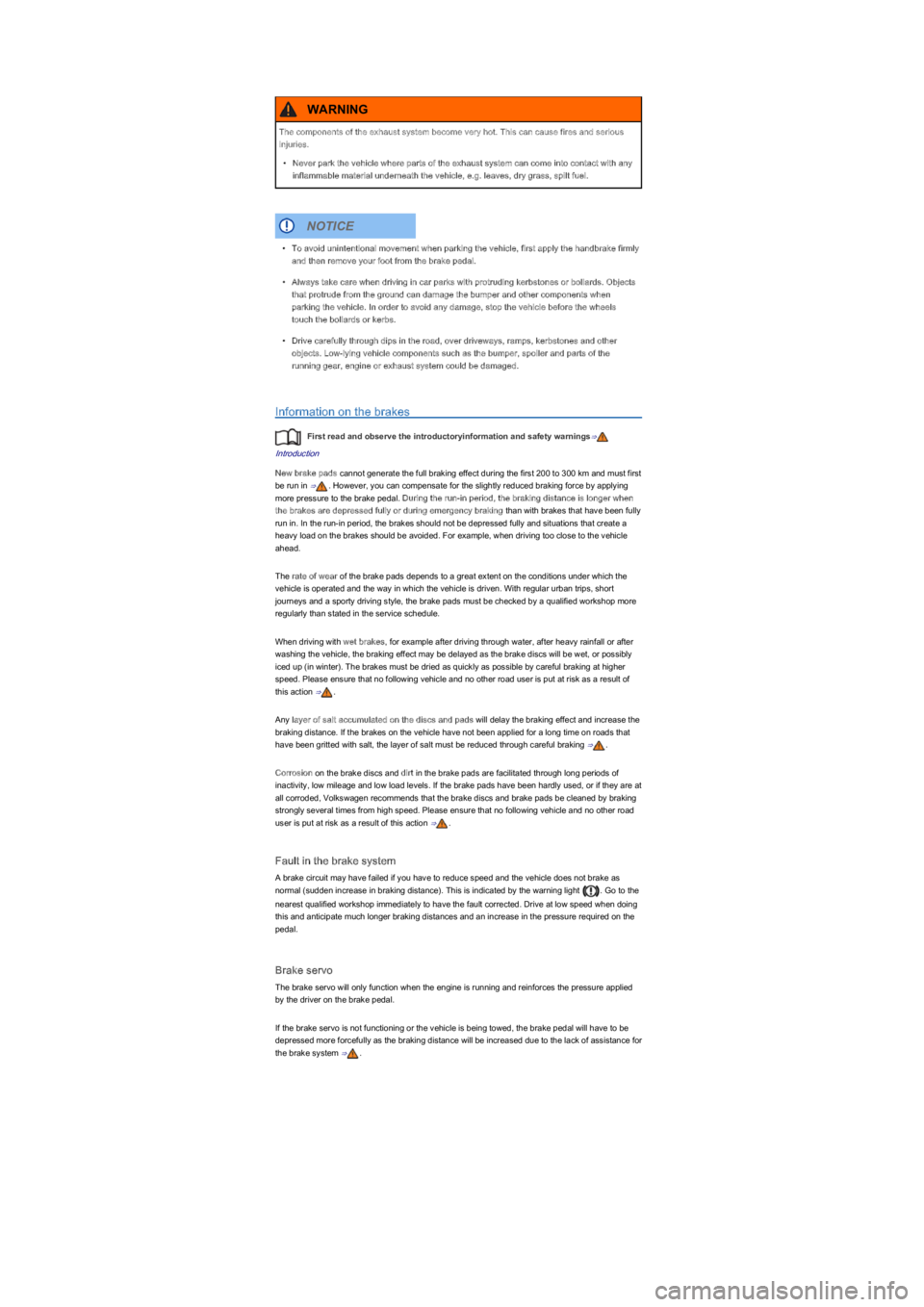
Information on the brakes
First read and observe the introductoryinformation and safety warnings⇒
Introduction
New brake pads cannot generate the full braking effect during the first 200 to 300 km and must first
be run in ⇒. However, you can compensate for the slightly reduced braking force by applying
more pressure to the brake pedal. During the run-in period, the braking distance is longer when
the brakes are depressed fully or during emergency braking than with brakes that have been fully
run in. In the run-in period, the brakes should not be depressed fully and situations that create a
heavy load on the brakes should be avoided. For example, when driving too close to the vehicle
ahead.
The rate of wear of the brake pads depends to a great extent on the conditions under which the
vehicle is operated and the way in which the vehicle is driven. With regular urban trips, short
journeys and a sporty driving style, the brake pads must be checked by a qualified workshop more
regularly than stated in the service schedule.
When driving with wet brakes, for example after driving through water, after heavy rainfall or after
washing the vehicle, the braking effect may be delayed as the brake discs will be wet, or possibly
iced up (in winter). The brakes must be dried as quickly as possible by careful braking at higher
speed. Please ensure that no following vehicle and no other road user is put at risk as a result of
this action ⇒.
Any layer of salt accumulated on the discs and pads will delay the braking effect and increase the
braking distance. If the brakes on the vehicle have not been applied for a long time on roads that
have been gritted with salt, the layer of salt must be reduced through careful braking ⇒.
Corrosion on the brake discs and dirt in the brake pads are facilitated through long periods of
inactivity, low mileage and low load levels. If the brake pads have been hardly used, or if they are at
all corroded, Volkswagen recommends that the brake discs and brake pads be cleaned by braking
strongly several times from high speed. Please ensure that no following vehicle and no other road
user is put at risk as a result of this action ⇒.
Fault in the brake system
A brake circuit may have failed if you have to reduce speed and the vehicle does not brake as
normal (sudden increase in braking distance). This is indicated by the warning light . Go to the
nearest qualified workshop immediately to have the fault corrected. Drive at low speed when doing
this and anticipate much longer braking distances and an increase in the pressure required on the
pedal.
Brake servo
The brake servo will only function when the engine is running and reinforces the pressure applied
by the driver on the brake pedal.
If the brake servo is not functioning or the vehicle is being towed, the brake pedal will have to be
depressed more forcefully as the braking distance will be increased due to the lack of assistance for
the brake system ⇒.
The components of the exhaust system become very hot. This can cause fires and serious
injuries.
•Never park the vehicle where parts of the exhaust system can come into contact with any
inflammable material underneath the vehicle, e.g. leaves, dry grass, spilt fuel.
WARNING
•To avoid unintentional movement when parking the vehicle, first apply the handbrake firmly
and then remove your foot from the brake pedal.
•Always take care when driving in car parks with protruding kerbstones or bollards. Objects
that protrude from the ground can damage the bumper and other components when
parking the vehicle. In order to avoid any damage, stop the vehicle before the wheels
touch the bollards or kerbs.
•Drive carefully through dips in the road, over driveways, ramps, kerbstones and other
objects. Low-lying vehicle components such as the bumper, spoiler and parts of the
running gear, engine or exhaust system could be damaged.
NOTICE
Page 105 of 211
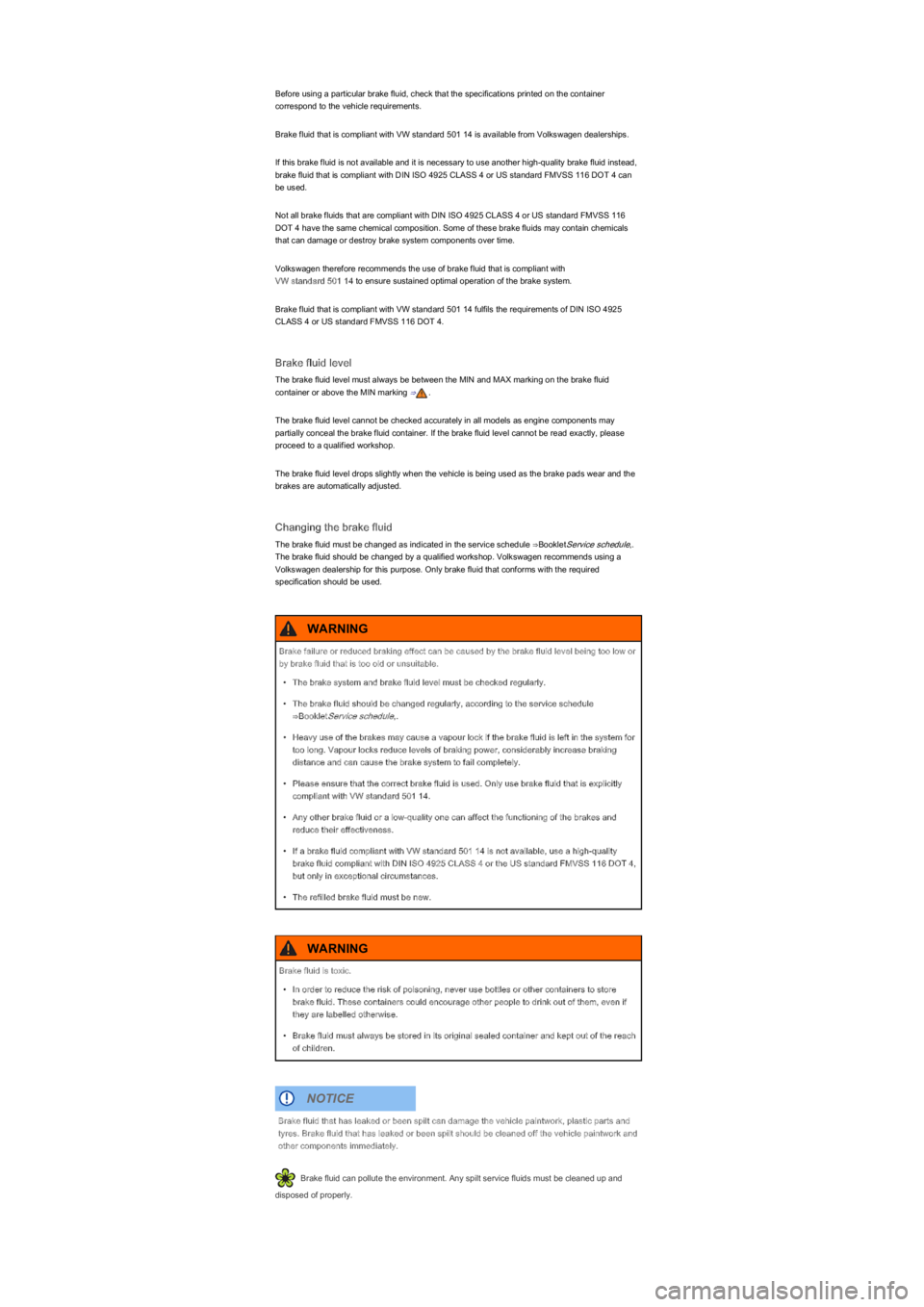
Before using a particular brake fluid, check that the specifications printed on the container
correspond to the vehicle requirements.
Brake fluid that is compliant with VW standard 501 14 is available from Volkswagen dealerships.
If this brake fluid is not available and it is necessary to use another high-quality brake fluid instead,
brake fluid that is compliant with DIN ISO 4925 CLASS 4 or US standard FMVSS 116 DOT 4 can
be used.
Not all brake fluids that are compliant with DIN ISO 4925 CLASS 4 or US standard FMVSS 116
DOT 4 have the same chemical composition. Some of these brake fluids may contain chemicals
that can damage or destroy brake system components over time.
Volkswagen therefore recommends the use of brake fluid that is compliant with
VW standard 501 14 to ensure sustained optimal operation of the brake system.
Brake fluid that is compliant with VW standard 501 14 fulfils the requirements of DIN ISO 4925
CLASS 4 or US standard FMVSS 116 DOT 4.
Brake fluid level
The brake fluid level must always be between the MIN and MAX marking on the brake fluid
container or above the MIN marking ⇒.
The brake fluid level cannot be checked accurately in all models as engine components may
partially conceal the brake fluid container. If the brake fluid level cannot be read exactly, please
proceed to a qualified workshop.
The brake fluid level drops slightly when the vehicle is being used as the brake pads wear and the
brakes are automatically adjusted.
Changing the brake fluid
The brake fluid must be changed as indicated in the service schedule ⇒BookletService schedule,.
The brake fluid should be changed by a qualified workshop. Volkswagen recommends using a
Volkswagen dealership for this purpose. Only brake fluid that conforms with the required
specification should be used.
Brake fluid can pollute the environment. Any spilt service fluids must be cleaned up and
disposed of properly.
Brake failure or reduced braking effect can be caused by the brake fluid level being too low or
by brake fluid that is too old or unsuitable.
•The brake system and brake fluid level must be checked regularly.
•The brake fluid should be changed regularly, according to the service schedule
⇒BookletService schedule,.
•Heavy use of the brakes may cause a vapour lock if the brake fluid is left in the system for
too long. Vapour locks reduce levels of braking power, considerably increase braking
distance and can cause the brake system to fail completely.
•Please ensure that the correct brake fluid is used. Only use brake fluid that is explicitly
compliant with VW standard 501 14.
•Any other brake fluid or a low-quality one can affect the functioning of the brakes and
reduce their effectiveness.
•If a brake fluid compliant with VW standard 501 14 is not available, use a high-quality
brake fluid compliant with DIN ISO 4925 CLASS 4 or the US standard FMVSS 116 DOT 4,
but only in exceptional circumstances.
•The refilled brake fluid must be new.
WARNING
Brake fluid is toxic.
•In order to reduce the risk of poisoning, never use bottles or other containers to store
brake fluid. These containers could encourage other people to drink out of them, even if
they are labelled otherwise.
•Brake fluid must always be stored in its original sealed container and kept out of the reach
of children.
WARNING
Brake fluid that has leaked or been spilt can damage the vehicle paintwork, plastic parts and
tyres. Brake fluid that has leaked or been spilt should be cleaned off the vehicle paintwork and
other components immediately.
NOTICE